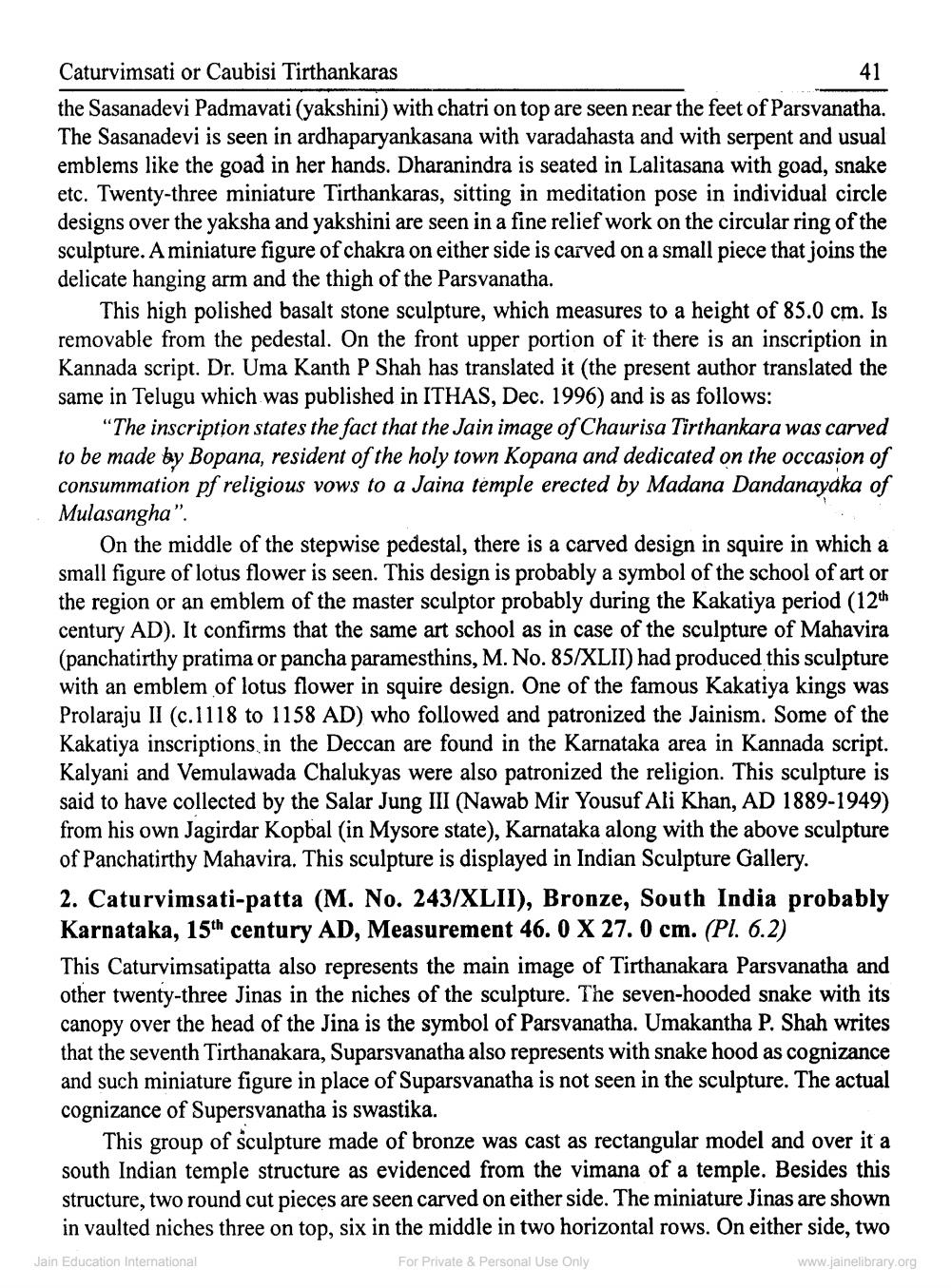________________
Caturvimsati or Caubisi Tirthankaras
41 the Sasanadevi Padmavati (yakshini) with chatri on top are seen rear the feet of Parsvanatha. The Sasanadevi is seen in ardhaparyankasana with varadahasta and with serpent and usual emblems like the goad in her hands. Dharanindra is seated in Lalitasana with goad, snake etc. Twenty-three miniature Tirthankaras, sitting in meditation pose in individual circle designs over the yaksha and yakshini are seen in a fine relief work on the circular ring of the sculpture. A miniature figure of chakra on either side is carved on a small piece that joins the delicate hanging arm and the thigh of the Parsvanatha.
This high polished basalt stone sculpture, which measures to a height of 85.0 cm. Is removable from the pedestal. On the front upper portion of it there is an inscription in Kannada script. Dr. Uma Kanth P Shah has translated it (the present author translated the same in Telugu which was published in ITHAS, Dec. 1996) and is as follows:
"The inscription states the fact that the Jain image of Chaurisa Tirthankara was carved to be made by Bopana, resident of the holy town Kopana and dedicated on the occasion of consummation pf religious vows to a Jaina temple erected by Madana Dandanayaka of Mulasangha”.
On the middle of the stepwise pedestal, there is a carved design in squire in which a small figure of lotus flower is seen. This design is probably a symbol of the school of art or the region or an emblem of the master sculptor probably during the Kakatiya period (12th century AD). It confirms that the same art school as in case of the sculpture of Mahavira (panchatirthy pratima or pancha paramesthins, M. No. 85/XLII) had produced this sculpture with an emblem of lotus flower in squire design. One of the famous Kakatiya kings was Prolaraju II (c.1118 to 1158 AD) who followed and patronized the Jainism. Some of the Kakatiya inscriptions in the Deccan are found in the Karnataka area in Kannada script. Kalyani and Vemulawada Chalukyas were also patronized the religion. This sculpture is said to have collected by the Salar Jung III (Nawab Mir Yousuf Ali Khan, AD 1889-1949) from his own Jagirdar Kopbal (in Mysore state), Karnataka along with the above sculpture of Panchatirthy Mahavira. This sculpture is displayed in Indian Sculpture Gallery. 2. Caturvimsati-patta (M. No. 243/XLII), Bronze, South India probably Karnataka, 15th century AD, Measurement 46. 0 X 27. 0 cm. (Pl. 6.2) This Caturvimsatipatta also represents the main image of Tirthanakara Parsvanatha and other twenty-three Jinas in the niches of the sculpture. The seven-hooded snake with its canopy over the head of the Jina is the symbol of Parsvanatha. Umakantha P. Shah writes that the seventh Tirthanakara, Suparsvanatha also represents with snake hood as cognizance and such miniature figure in place of Suparsvanatha is not seen in the sculpture. The actual cognizance of Supersvanatha is swastika.
This group of sculpture made of bronze was cast as rectangular model and over it a south Indian temple structure as evidenced from the vimana of a temple. Besides this structure, two round cut pieces are seen carved on either side. The miniature Jinas are shown in vaulted niches three on top, six in the middle in two horizontal rows. On either side, two
Jain Education International
For Private & Personal Use Only
www.jainelibrary.org




